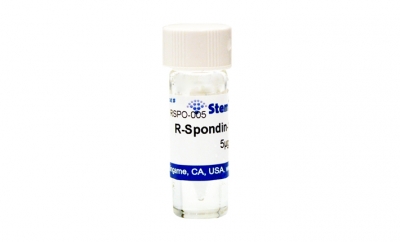| Source | human 293 cells | M.W. | 25.6 kDa | CAS No. | |
|---|---|---|---|---|---|
| Structural Info | |||||
| Formulation | Lyophilized in sterile filtered solution of PBS. | ||||
| Reconstitution | Before reconstitution, a brief spin is recommend to drive down any material dislodged from the bottom of the tube. The lyophilized protein should be reconstituted in sterile H2O to a desired concentration. | ||||
| Stability | The lyophilized protein is stable for at least one year if stored at -80 °C. Reconstituted protein is stable for at least four weeks at 4 °C, but should be stored in aliquots at -80 °C for longer term. Avoid repeated freeze and thaw. | ||||
| Purity | Greater than 90% as determined by SDS-PAGE analysis | ||||
| Biological Activity | The activity was determined by using a TCF reporter gene assay in cultured human cells. The EC50 ranges from 5 - 20 ng/ml in the presence of 10 ng/mL human WNT-3a. | ||||
| Country of Origin | USA | ||||
R-spondin-1 (RSPO-1) is a natural enhancer of the canonical WNT pathway. When used together with WNT proteins that activate the
beta-catenin pathway, R-spondin-1 enhances the activity of canonical WNT proteins by binding to LGR5 and LGR4 (refs.)
Injection of recombinant RSpondin-1 into mouse causes activation of the βcatenin pathway and proliferation of intestinal crypt cells, which forms the basis for a clinical trial in amelioration of chemotherapy-induced colitis.
The Predicted MW of full-length R-Spondin-1 is 25.6 kDa, and due to glycosylation it runs on SDSPAGE at ~39 kDa under
reducing conditions. StemRD’s R-Spondin-1 is produced in human 293 cells as a secreted protein (without tag) and purified by a series of chromatography.
Refs: de Lau, et al, LGR5 homologues associate with Wnt receptors and mediate R-spondin signaling. Nature. 2011 July 4; 476: 293;
Carmon, et al, R-spondins function as ligands for the orphan receptors LGR4 and LGR5 to regulate Wnt/beta-catenin signaling. PNAS. 2011 Jul 12; 108: 11452.
http://www.ncbi.nlm.nih.gov/pubmed/22965990
